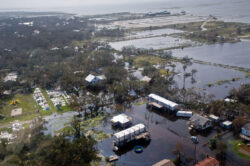Hurricane Gustav
Hurricane Gustav was the first major storm to test New Orleans’s rehabbed defenses after Hurricane Katrina.

United States National Guard
Hurricane Gustav damage.
Days before the third anniversary of Hurricane Katrina, a major storm moved northwestward over Haiti, where it killed seventy-seven people, rapidly strengthening on its way to Louisiana. Hurricane Gustav, the first to test New Orleans’s rehabbed defenses after the catastrophe of the 2005 season, quickly raised fears of a déjà vu incident on the anniversary, drawing attention during a frenzied election year’s Republican National Convention. By Sunday, August 31, New Orleans Mayor Ray Nagin had alarmingly proclaimed during a press conference that Gustav was the “Mother of All Storms,” and “the storm of the century,” with a six hundred-mile-wide girth set to threaten all in its path, and he urged residents to get out while they still could. Contraflow-directed interstates quickly jammed as 1.9 million people fled south Louisiana and neighboring states.
As panic set in, resources arrived. Governor Bobby Jindal activated two thousand Louisiana National Guard troops. The federal government mobilized seven hundred search-and-rescue personnel, 564,000 ready-to-eat meals and water for 350,000 other responders. Meanwhile, twenty-four-hour news media outlets replayed simulation models of levee breaks at various known weakened junctures throughout the extended New Orleans area using scenarios run by Louisiana State University scientists, amping up fears.
By the time Gustav made landfall on the morning of September 1, it had dissipated from the anticipated Category 4 level to a Category 2, and swept west of New Orleans to Cocodrie in Terrebonne Parish. The spared direct hit on New Orleans was met with tentative relief as Louisianans waited for the potential fifteen feet of storm surge expected to impact that state’s coastline. Thankfully both the Industrial Canal and the new Harvey Canal on the West Bank held in the threat of flooding. Even the Plaquemines Parish overtopped levee that threatened to flood the Braithwaite subdivision was abated due to last-minute sandbagging. The electrical grid suffered extensive damage, leaving half the state without power.
While Gustav spared the New Orleans area, the parishes of Terrebonne, St. Mary, and Lafourche were not as lucky. With a direct hit on Cocodrie, coastal residents in southern parts of Terrebonne Parish around Montegut and Pointe-Aux-Chenes experienced strong winds that knocked shingles off houses and sent oranges flying from trees like bombs. By the time the storm reached the Houma area on Monday, coastal residents agreed that Gustav was one of the worst storms they had experienced, with forty-eight deaths attributed to it. Meanwhile, damaging winds extended outward, stretching between Baton Rouge (at eighty-two mph) and Lafayette (at seventy-five mph).
As Gustav continued to dissipate, state residents faced another challenge: returning home after evacuation. While New Orleans officials actively encouraged residents to stay away until September 4, those that did return met long waits for reentry past checkpoints and jammed interstates like those they experienced on their way out. Even before residents could resettle and begin cleaning up after this $6 billion storm, another major storm, Ike, loomed in the Gulf.
